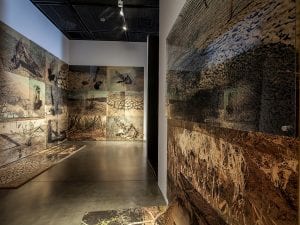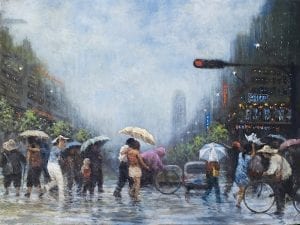Perhaps the single most notable feature of De/Constructing China at the Asia Society Museum, New York, is the continuing relevance of the images taken more than a decade ago from 1998–2005. Selected from the Asia Society’s permanent collection, images and videos of China’s frenetic modernisation made by some of the most prominent Chinese artists such as Cao Fei, Song Dong, and Chen Shaoxiong, amongst others, showcase a country in a state of rapid transition. Yet, despite the artists’ stance as critical vigilantes documenting large-scale buildings that reshaped the mindset and skyline of their country, one can’t help but be in awe of their portrayal of the changes. The images are in equal parts a commentary on the accelerated influx of modernity, and the persuasive power of the governments’ zealous effort to surge ahead.
The exhibition opens with Zhang Dali and Sze Tsung Leong’s photographs of the scale of Chinese modern architecture. In Demolition (1998), Dali features an enormous excavated pit for the foundation of an impending construction. Juxtaposed with a high-rise fitted with blue tinged UV protected windows, Dali lays the groundwork for showcasing China’s growing consumer society. Speedy urban development and single-minded focus on economic prowess replaced China’s communist ideology of yesteryear. With the Cultural Revolution of the 60s, relevance for historical monuments was diminished. Notwithstanding public sentiment for old structures, Dali reveals how the government plowed ahead.
Chen Shaoxiong’s lyrical black and white video Ink City (2005) is made up of a series of traditional ink drawings which expose the expeditious growth of a cityscape, accompanied by a soundtrack that captures the ambient sound of a metropolis on the move. Although the video is critical of China’s sweeping elimination of an agrarian society, Shaoxiong’s methodology has the reverse effect on the viewer. Images of mammoth sized industrial shovels, ladders and machinery used to hoist raw materials and facilitate construction point to a modern, industrialised future. The tenor of the background traffic is no different than that of a western city during rush hour. Contrary to one’s expectations, the video harnesses the potency of China’s new-found capitalism, and its goal for instrumenting radical change.
Even Lin Yilin’s disparaging video of the artist steadily manoeuvring his way across a busy street, with a symbolic wall of heavy concrete bricks meant to signify caution and deceleration of the country’s pace, is dwarfed by mega fabrications and unfettered expansion all around him. In China the incursion of modernity and transformation eclipsed displacement of the local people. The government’s plan overshadowed what Song Dong’s poetic video Burning Mirror (2001) attempts to uncover. Here a burning plastic sheet gradually unveils a working class neighborhood in disarray. The searing flames become emblematic of a populace that is permanently and harshly removed. It seems that diversification for the Chinese comes at a heavy price.
Only when accompanied by Cao Fei’s satirical videos Rabid Dogs (2002) and Mirror by China Tracy (AKA: Cao Fei) Second life Documentary Film (2007) which promulgate the confinement of cultural mores and curtailment of individual freedom, does the jarring disparity between the growth of the economy versus individual evolution become apparent. In Rabid Dogs, characters play-acting as dogs run amok in an office setting and unmask the feral side of human nature. Cao Fei’s alter ego China Tracy’s elaborate fantasy, inspired by popular western culture to engage in life with unrestrained discretion, is an attempt to highlight this paucity.
Yet by De/Constructing China, the artists unravel a double bind. While the artists continue to be critical of China’s remarkable headway, it is their very mastery of the available technical knowledge that enables the luminosity of their work to determine change. Ultimately such works will continue to be made until the Chinese government strikes a balance between economic might and complete individual freedom.
De/Constructing China, until 19 July, The Asia Society Museum, New York.
Bansie Vasvani
For more information visit www.asiasociety.org
Follow us on Twitter @AestheticaMag for the latest news in contemporary art and culture.
Credits
1. Wang Qingsong, Follow Him, 2010. Courtesy of Wang Qingsong Studio.





